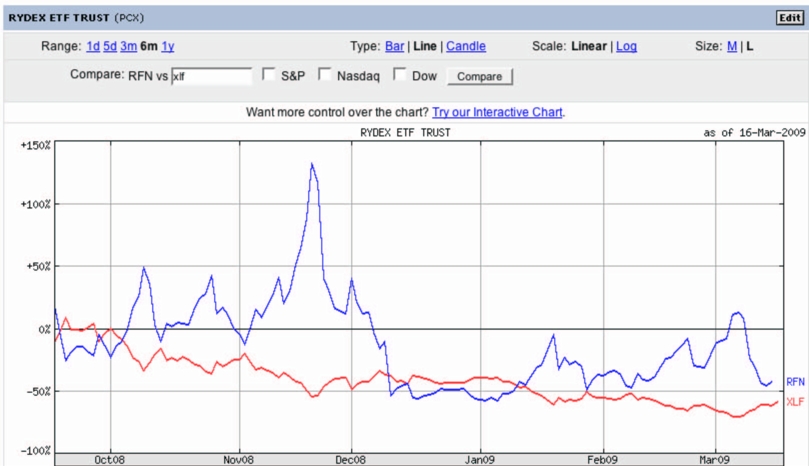Exchange traded funds (ETFs) provide some interesting features. Often they charge some very low expense ratios, offer liquidity as they trade during the day, not just at day’s end, and they let you slice the market to choose a sector you wish to invest in, as with the S&P Spider Select ETFs.
Recently, I’ve taken note of the inverse ETFs which offer the ability to profit in a falling market by buying an EFT structured to be short, or in some cases twice short. Case in point is RFN, the Rydex Inverse 2X S&P Select Sector Financial ETF, which in theory, will provide twice the inverse return of the S&P Financial Sector (XLF). Now, given the poor returns the XLF has seen these past 6 months, one should be happy to have been in an inverse ETF, or would they?

You can see that in these 6 months, XLF was down a bit over 50%, and even after expenses, you’d think RFN would have returned 90% or so, yet it’s also down, about 45%. You can also see from the chart that there was a point in mid-November when the return was what was expected, a bit more in fact, but it would appear that over the longer term, even in just 6 months, the use of this ETF just makes no sense, you’d have been better off just shorting the XLF if you expected it to drop. Disclaimer – I did not discover this on my own, a fellow poster on the Usenet group misc.invest.financial-plan brought this to the board’s attention.
UPDATE – a sharp-eyed reader sent me a comment prompting me to look into this further. The RFN declared a dividend in December equal to about half its value, so if the Yahoo chart above were adjusted properly, RFN would show about a 10% gain assuming the money were immediately reinvested at the time of the dividend. +10% when you’d expect something closer to +90% or so. I should have caught this as I was writing this post, but still the ETF is disappointing.
Joe

Can you explain what happened in Dec/08 when RFN dropped suddenly with no equivalent movement in XLV? I see a similar drop a few days later in SH vs. the S&P and in both cases it kind of accounts for the difference between the actual and the expected returns.
I’ve owned and traded a few etf’s and like the name of your title. I’ve also notice the not acting the way I expected especially when trading them intra day and expecting a move in them.